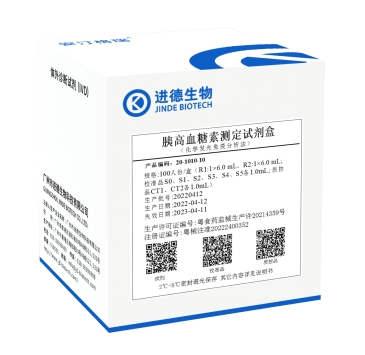Glucagon(胰高血糖素)
Glucagon Chemiluminescent Immunoassay

☑️ Description
Glucagon is produced by the alpha cells of the islets of Langerhans of the pancreas in response to a decrease in plasma glucose concentrations and in response to increased concentrations of specific amino acids.2 The glucagon precursor protein undergoes tissue-specific post-translation processing.2 Glucagon secretion is controlled by a number of factors. In nondiabetic individuals, secretion is stimulated by protein-rich meals, but inhibited by carbohydrate-rich meals. Hypoglycemia activates the autonomic nervous system which stimulates glucagon release into the portal circulation.3-5 Glucagon release is also regulated in a paracine manner by insulin, zinc and other factors secreted from neighboring β- and δ-cells within the islet of Langerhans.5 In healthy individuals, glucagon released is inhibited by hyperglycemia, mixed nutrient meals, and oral intravenously administered amino acids.
☑️ How Does it Work?
Glucagon is a counter-regulatory hormone opposing the actions of insulin in glucose homoeostasis. The intravenous administration of glucagon raises blood glucose substantially in nondiabetic individuals.Glucagon is thought to play an important role in the maintenance of fasting and postprandial glucose homeostasis. By stimulating hepatic glucose output, glucagon counterbalances the action of insulin and serves to maintain circulating glucose and prevent insulin mediated hypoglycemia. Blockade of endogenous glucagon secretion with somatostatin causes glucose concentrations to decrease.
A highly specific glucagon receptor is abundantly expressed on hepatocytes.6 Glucagon binding to this receptor leads to increased hepatic glucose production, fatty acid oxidation and ketogenesis.Glucagon stimulates glycogenolysis and gluconeogenesis, changing the liver from an organ of glucose release. Glucagon secretion inhibits gastric emptying, increases gastric output, increases bile flow and increases cardiac muscle contraction. Glucagon also has lipolytic effects.
Insulin treatment of diabetic patients can cause acute hypoglycemia which is often exacerbated by a deficient glucagon response. The exact pathophysiologic mechanisms for this dysregulation is not fully defined but has been attributed, in part, to a lack of intra-islet insulin effect.
Alternatively, some patients with controlled type 1 diabetes experience inappropriately elevated plasma glucagon levels in the context of hyperglycemia.Both type 1 and type 2 diabetes frequently exhibit an inappropriately high glucagon response to a meal. The high levels of glucagon have been shown to contribute importantly to diabetic hyperglycemia and can result in ketoacidosis.11 Relative hyperglucagonemia, in the setting of deficient insulin secretion may contribute to the development of fasting and postprandial hyperglycemia in the patients.
Increased plasma glucagon levels have been demonstrated in many forms of physiological stress that are not typically associated with hypoglycemia.Hyperglucagonemia has been documented in patients with trauma, burns, surgery, sepsis, hemorrhage, acute myocardial infarction, cardiac arrest and neonatal hypoxia.
Contact Us
Follow us
 Wechat
Wechat

